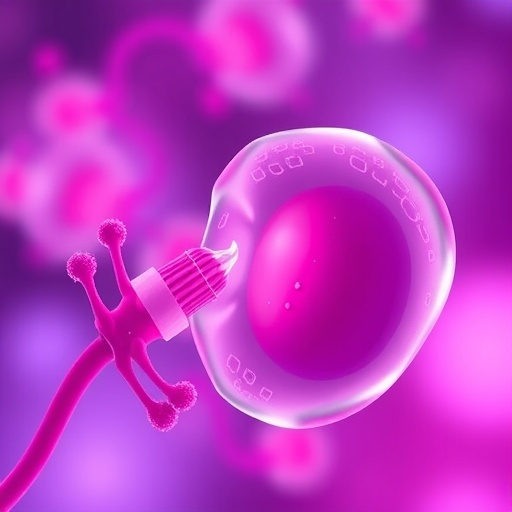Recent research has shed light on the complexities of ovarian biology, particularly regarding the delicate interplay between oocytes and granulosa cells in ovarian follicles. In the context of chemotherapy—a treatment that unfortunately leads to significant infertility issues due to the adverse effects it inflicts on ovarian function—scientists have made a significant breakthrough with the findings of a new study. This work, conducted using a mouse model, reveals that luteinizing hormone (LH) plays a critical role in preserving communication between oocytes and granulosa cells, which is crucial during the primordial stage of follicle development.
The ovarian follicles consist of oocytes surrounded by granulosa cells, which support the growth and maturation of the oocytes. The communication between these two cell types is fundamental for the normal functioning of the ovary, as it regulates several critical processes including hormone production and follicular development. Unfortunately, chemotherapy regimens that include alkylating agents often pose a severe risk to ovarian reserve and reproductive capabilities by targeting rapidly dividing cells, including those in the ovaries.
Alkylating agents, commonly used for treating a variety of cancers, have been shown to disrupt these essential cellular communications, leading to impaired oocyte quality and eventual infertility. The findings from Del Castillo et al.’s study show promise in mitigating these effects through the role of luteinizing hormone, revealing insights that could pave the way for fertility preservation strategies in cancer patients undergoing chemotherapy.
In the study, researchers explored the impact of LH administration on follicles subjected to chemotherapy with alkylating agents. Their observations indicated that LH significantly mitigated the negative effects of chemotherapy on oocyte-granulosa cell communication. This finding is particularly important because it opens up new avenues for therapeutic interventions that could protect ovarian function in women undergoing cancer treatments.
Further investigations revealed that LH not only preserves communication between oocytes and granulosa cells but also enhances the viability and functionality of the oocytes under chemotherapy stress. By maintaining this critical interaction, LH may facilitate the normalization of hormone signaling and maintain the structural integrity of the follicular environment, thereby supporting oocyte maturation even in the presence of damaging agents.
Researchers employed a mouse model to simulate the effects of chemotherapy and the protective role of LH in a controlled environment. The findings suggest that even in an adverse environment created by alkylating agents, LH acts as a protective agent, essentially acting as a guardian for developing oocytes. This could be a game-changer for oncologists dealing with fertility preservation in young women diagnosed with cancer.
Moreover, the study pointed to potential clinical implications. For cancer patients, the incorporation of LH treatment prior to and during chemotherapy could significantly improve reproductive outcomes. This is particularly vital as fertility preservation options are currently limited, and many cancer survivors face the daunting reality of infertility.
The timing of LH administration appears to be crucial, as the study illustrated that early intervention at the primordial stage could yield the best outcomes. This emphasizes the need for oncologists to consider hormone therapy as a complementary approach in cancer treatment protocols when managing female patients of reproductive age.
In addition, the findings encourage further exploration into the hormonal milieu of the ovaries and their relationship to ovarian reserve and fertility. By understanding the molecular pathways involved in oocyte-granulosa cell communication and the role of lutropin, more targeted therapies can be developed that not only protect fertility during chemotherapy but also enhance overall reproductive health.
This groundbreaking study stands to influence how fertility preservation is managed in clinical settings and highlights the importance of integrating reproductive endocrinology with oncology. The authors’ insights may lead to new guidelines fostering the use of LH in protocols aimed at preserving female fertility during cancer treatment.
As research continues to evolve in this area, it could foster innovative strategies that not only protect oocyte quality but also consider the emotional and psychological wellbeing of cancer patients facing fertility loss. It emphasizes the need for a holistic approach that includes discussions on reproductive options alongside oncological treatment.
Overall, this study serves as a reminder of the intricate balance within reproductive biology and the potential for scientific advancements to transform current medical practices in reproductive health and oncology. The role of luteinizing hormone emerges not merely as a supporting player but perhaps a central figure in safeguarding reproductive potential against the backdrop of chemotherapy.
The implications of such findings are vast and highlight the essential interplay between hormones and cellular communication within the ovaries, paving the way for future research that may unveil similar protective mechanisms in other hormonal pathways influencing reproductive health.
Lastly, as the scientific community explores these groundbreaking findings, collaboration across molecular biology, reproductive medicine, and oncology will be paramount. There is a collective responsibility to translate these laboratory breakthroughs into clinical applications—a challenge that could define the future of reproductive health in cancer care.
Subject of Research: The Role of Luteinizing Hormone in Oocyte–Granulosa Cell Communication and Fertility Preservation during Chemotherapy.
Article Title: Luteinizing Hormone Preserves Oocyte–Granulosa Cell Communication in Growing Follicles Exposed to Chemotherapy with Alkylating Agents at the Primordial Stage in a Mouse Model.
Article References:
Del Castillo, L.M., Ramírez-Martín, N., Soriano, M.J. et al. Luteinizing Hormone Preserves Oocyte–Granulosa Cell Communication in Growing Follicles Exposed to Chemotherapy with Alkylating Agents at the Primordial Stage in a Mouse Model.
Reprod. Sci. (2025). https://doi.org/10.1007/s43032-025-01936-1
Image Credits: AI Generated
DOI: 10.1007/s43032-025-01936-1
Keywords: Luteinizing Hormone, Oocyte, Granulosa Cells, Chemotherapy, Fertility Preservation, Ovarian Biology, Alkylating Agents, Reproductive Health.




